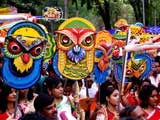When P took the IELTS Speaking test in Bangladesh, he was asked the following questions:
Interview
– What is your name?
– What should I call you?
– Where are you from?
– Why is your home town interesting?
– Are there any interesting places in your home town? Which ones?
– How many hours of sleep does a person need?
– How many hours do you sleep each day?
– What do you do to fall asleep quickly?
– What are the disadvantages of lack of sleep?
– How many hours of sleep does an older person need?
Cue Card
Talk about a story someone told you, that you remember well. Please say
– Who told you the story?
– When did they tell you the story?
– Why do you remember this story?
– Explain why it is interesting to you.
Follow up question: Do you tell stories often?
Discussion
– What is the importance of story telling?
– Do you think story telling is important for students?
– What kind of stories do young children like?
– How about older children?
– Did you ever tell any story to anyone?
– What story was it?
– Do you think children like adventurous stories?
– Do you think children like technology more than story telling?
– How can you use technology for story telling?
– What are the disadvantages of technological story telling?
– Do you use technology often for story telling?
– Do you think children should use technology for story telling or listen to a real person’s story?



